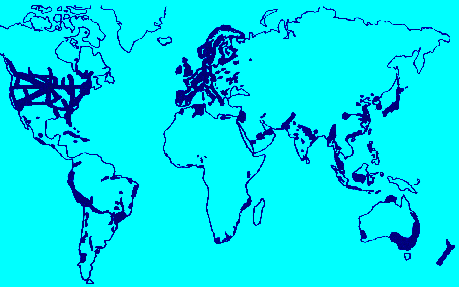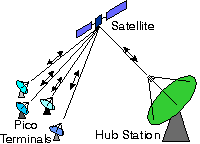
 |
JPL's Wireless Communication Reference WebsiteChapter:
Network Concepts and Standards
|
However, for systems with larger traffic loads, with more local applications, satellite communication systems may experience the disadvantage that local possibilities of frequency re-use are limited, except for satellites with very low orbits and highly directional antennas.

Expected coverage of cellular telephone systems by the year 2000.
In due course, communication may thus need to be transferred to ground- based cellular mobile networks. Satellite technology is particularly suited to cover rural, sparsely populated areas. Moreover satellite systems have the important ability to offer an early service which only later becomes available in the standard fixed infrastructure. Earlier examples of this have been international satellite television programme distribution and video conferencing, now also possible by broadband optical cables, intercontinental digital leased lines and 'hot lines' for journalists and statesmen travelling in less developed regions.
Selected
Features of Digital Land Mobile Satellite Communication Systems
Offering Voice, Data and Fax Services.
Compiled by Miquele Dlodlo
B,C & M | |||||||
| Orbit (km above ground) |
35 800 | 10 335 | 10354 | 780 | 1 401 |
1 018 | 520-7 846 ell(e); 8 040 circular(c) |
| No., Active Satellites | 4 | 10 | 12 | 66 | 48 | 48 | 10 e; 6c |
| Spare Capacity | 5 | 2 | 3 | 6 | 8 | 4 | 2 e; 1c |
| Orbital Planes | 1 | 2 | 3 | 6 | 8 | 4 | |
| Inclination deg. | 0 | 45 | 55 | 86.4 | 52 | 90 | 116.5 e; 0 c |
| Min. Single Hop Delay (ms) | 240 | 68.95 | 69.07 |
5.20 | 9.35 | 6.79 | 3.47 |
| Terminal Modes | 1 | 2 | 2 | 2 | 2 | 2 | |
| Data Rates (kbps) | 2.4 | 9.6 | 2.4 | 2.4 | 2.4 |
0.3-9.6 | |
| Voice Rate (kbps) | 4.8 | 4.8 |
2.4/4.8 | 2.4/4.8/9.6 | 4.8 | 4.15 |
|
| Multiple Access | |||||||
| Modulation | |||||||
| Voice Circuits per Satellite |
4 500 | 2 300 | 3 840(1100) | 2 808(1354) | |||
| Downlink Freq. GHz (traffic) | 1.5 | 1.980-2.010 | 2.4835-2.500 | 1.616-1.6265 | 2.4835-2.500 | 2.4835-2.500 | 2.4835-2.500 |
| Uplink Freq. GHz. (traffic) | 1.6 | 2.17-2.20 | 1.61-1.6265 | 1.61-1.6265 | 1.61-1.6265 | 1.61-1.6265 | 1.61-1.6265 |
| Additional Services | messaging | paging | paging messaging position location | paging messaging position location | paging | paging messaging position location | |
Notes: Blank spaces indicate cases where accurate information
was unavailable at compilation time.
 The tendency here is towards smaller and transportable ground stations. This
is shown by the popularity of the very small aperture terminals (VSATs).
VSATs are small satellite groundstations, normally linked within a
VSAT network. The size of a VSAT is limited to a maximum antenna diameter of
approximately 240 cm. VSATs are suitable for low rate data traffic (approximately 64
kbit/s).
The tendency here is towards smaller and transportable ground stations. This
is shown by the popularity of the very small aperture terminals (VSATs).
VSATs are small satellite groundstations, normally linked within a
VSAT network. The size of a VSAT is limited to a maximum antenna diameter of
approximately 240 cm. VSATs are suitable for low rate data traffic (approximately 64
kbit/s).
 Slides on Mobile Satellite Systems
Slides on Mobile Satellite SystemsThe actual research and development carried out so far into non-GEOS systems (the best prospect for isolated rural people and the global PCS market) has been very expensive for the companies involved. As a result, the initial cost of services is quite likely to be out of reach of the isolated rural communities of the developing world so that the gap between the developed and the underdeveloped might at the outset widen instead of closing as desired. Hence, serious thought needs to be given to the question of how the pricing of basic services will be structured in order to avert the possible widening of the gap.